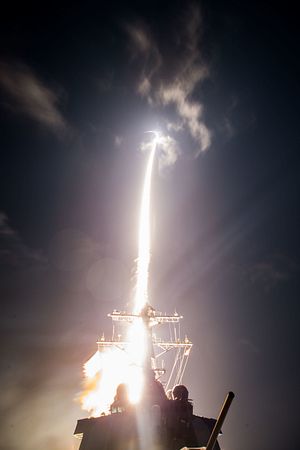The U.S. Missile Defense Agency will, for the first time, test a Standard Missile 3 (SM-3) Block IIA interceptor against a target representing an intercontinental-range ballistic missile later this year, according to a recent report by Naval News. The test, codenamed FTM-44, is part of a testing program for the SM-3 system mandated by the U.S. Congress.
According to comments by Missile Defense Agency spokesperson to Naval News, the FTM-44 test “is scheduled for FY20-Q3 and will be conducted in the Pacific Ocean.” The test will involve a ”threat representative” ICBM target, she added. The specific target missile will be the Northrop Grumman ICBM T2 target.
The SM-3 Block IIA is part of the SM-3 development program between the United States and Japan. It was developed and designed to handle targets in the short-range (300 km to 1,000 km range) to intermediate-range (3,000 to 5,500 km range) class of missiles.
Currently, a handful of SM-3 Block IIA interceptors are in the U.S. Navy‘s inventory. The system is designed for use abroad Aegis Ballistic Missile Defense system equipped warships, providing an at-sea capability against ballistic missiles. The SM-3 Block IIA employs a kinetic kill vehicle to destroy ballistic missile reentry vehicles through physical collision.
Currently, the United States operates a single missile defense system — the Ground-Based Midcourse Defense (GMD) system — to defend the contiguous United States against ICBM-class threats. The GMD system entered development in the early 2000s to defend against “limited” threats from states like North Korea and Iran.
In 2017, North Korea demonstrated an intercontinental-range capability with two missiles, the Hwasong-14 and Hwasong-15. Iran has not demonstrated such a capability and self-limits the range of its ballistic missiles to around 2,000 kilometers.
Both China and Russia see U.S. efforts to develop systems capable of destroy ICBM-class reentry vehicles as a threat to their strategic nuclear deterrents. If the SM-3 Block IIA is successfully developed into an anti-ICBM system, it would considerably multiply the set of interceptors available to the United States to defend against ICBMs.
As of the 2019 Missile Defense Review, a high-level Trump administration document on ballistic and cruise missile defense, the political objective of GMD and other prospective counter-ICBM systems remains defense against “limited” threats, like those from North Korea.
The Missile Defense Review noted that the United States “relies on deterrence to protect against large and technically sophisticated Russian and Chinese intercontinental ballistic missile threats to the U.S. homeland.”
However, U.S. President Donald J. Trump, while presenting the Review, said that the U.S. goal was “to ensure that we can detect and destroy any missile launched against the United States — anywhere, anytime, anyplace.”

































